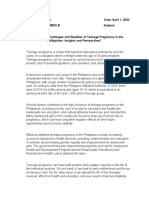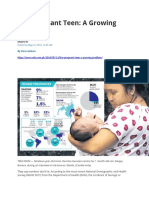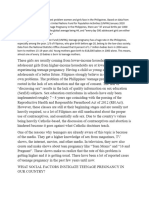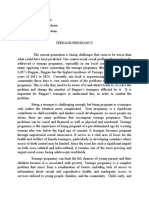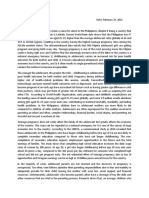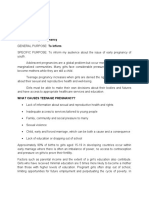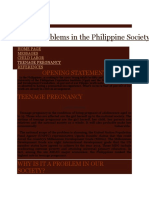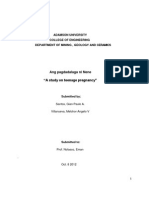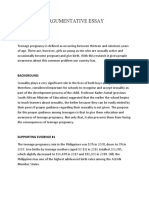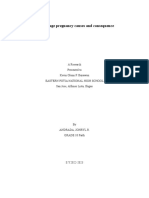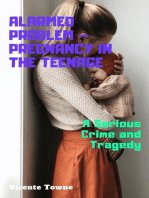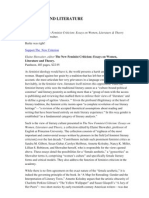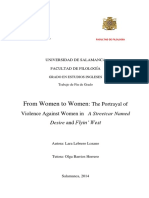Professional Documents
Culture Documents
Socioeconomic Impacts
Socioeconomic Impacts
Uploaded by
trinojp181Original Title
Copyright
Available Formats
Share this document
Did you find this document useful?
Is this content inappropriate?
Report this DocumentCopyright:
Available Formats
Socioeconomic Impacts
Socioeconomic Impacts
Uploaded by
trinojp181Copyright:
Available Formats
Teenage pregnancy is when a woman under 20 gets pregnant.
It usually refers to teens
between the ages of 15-19. But it can include girls as young as 10. It’s also called teen
pregnancy or adolescent pregnancy. According to the Philippines Statistics Authority Teenage
pregnancy among Filipino women aged 15 to 19 years declined from 8.6 percent in 2017 to 5.4
percent in 2022. Among women aged 15 to 19 years who have ever been pregnant as of 2022,
the highest percentage was recorded in woman aged 19 years (13.3%). This was followed by
women aged 18 years (5.9%) and women aged 17 years (5.6%). As expected, the lowest
percentage of women aged 15 to 19 years who have begun childbearing was for those who
were aged 16 years (1.7%), followed by women aged 15 years (1.4%). Teenage pregnancy
rates are increasing, which is a serious issue that has to be solved. To support young people
through their way through the difficulties of early motherhood, it is important that society
understand the fundamental causes of this problem and discover practical solutions.
Socioeconomic Impacts
Teenage pregnancy can have profound socioeconomic consequences, particularly for
young mothers that are mostly at the age of 15-19 year’s old. “The United Nations Population
Fund (UNPF), back in 2019, said the Philippines has one of the highest teenage pregnancy
rates among ASEAN member states, with over 500 teens becoming pregnant and giving birth
every day”. Disruptions to educational attainment and limited access to economic opportunities
can perpetuate cycles of poverty and social marginalization. Furthermore, the financial burden
of raising a child at a young age can exacerbate existing financial challenges, further limiting the
prospects of teenage parents and their families. Comprehensive support systems, including
educational and vocational assistance, are crucial to mitigate these impacts.
One of the main concerns surrounding the increasing rates of teenage pregnancy is the
potential impact on the health and well-being of both the teenage mothers and their babies.
Young mothers may face an increased risk of complications during pregnancy and childbirth due
to their bodies not yet being fully physically developed. This can lead to higher rates of maternal
and infant mortality, underscoring the urgent need for comprehensive support and healthcare
services for adolescent mothers.
In addition to health risks, teenage pregnancy can also impact the educational
opportunities and economic prospects of young parents. Many teenage mothers may find
themselves forced to drop out of school to care for their child, limiting their access to higher
education and better job prospects. This cycle of limited educational and economic opportunities
can perpetuate the cycle of poverty for young parents and their children, making it crucial to
address teenage pregnancy as a multifaceted societal issue.
Furthermore, the increasing rate of adolescent pregnancies highlight how important it is
for young people to have access to comprehensive sex education and reproductive health
services. Teens can be empowered to make decisions about their sexual health and avoid
unwanted pregnancies by being given accurate information on family planning, safe sex
practices, and contraception. We may attempt to lower the number of adolescent pregnancies
and promote the wellbeing of teenagers in our communities by supporting youth resources and
education.
In conclusion, the increasing rates of teenage pregnancy require a concerted effort to
address the complex challenges faced by young parents and their families. By prioritizing
access to healthcare, education, and support services for teenagers, we can create a more
supportive environment for adolescent mothers and work towards preventing unintended
pregnancies in the future. It is essential for policymakers, healthcare providers, educators, and
communities to collaborate on solutions that empower young individuals to make informed
choices about their reproductive health and well-being.
You might also like
- Position Paper The Social Problem of Teenage Pregnancy in The PhilippinesDocument2 pagesPosition Paper The Social Problem of Teenage Pregnancy in The PhilippinesEunice Shyra Bucsit85% (20)
- Feminism Is Not Really A Third World IssueDocument3 pagesFeminism Is Not Really A Third World IssueHijab Fatima67% (3)
- A Feminist Analysis of - An Awkward Situiation - AlcudiaDocument1 pageA Feminist Analysis of - An Awkward Situiation - AlcudiaStella Alcudia100% (1)
- Teenage PregnancyDocument3 pagesTeenage PregnancyJhon Pol CailaoNo ratings yet
- Teenage Pregnancy Brief DiscussionDocument3 pagesTeenage Pregnancy Brief DiscussionJoanna Peroz100% (1)
- The Difficulties and Implications of Teenage Pregnancy To The Teen Age Filipino Mothers - Topic Matrix - Performance Task # 1Document5 pagesThe Difficulties and Implications of Teenage Pregnancy To The Teen Age Filipino Mothers - Topic Matrix - Performance Task # 1Maia Isabelle GuintoNo ratings yet
- Chapter 1Document4 pagesChapter 1Faisal Tuazon IINo ratings yet
- Teenage Pregnancy 2Document22 pagesTeenage Pregnancy 2Falusi Blessing OlaideNo ratings yet
- ProjectDocument6 pagesProjectVicxie Fae CupatanNo ratings yet
- Situation AnalysisDocument8 pagesSituation AnalysisKeena Joy Awisan - Pinas100% (1)
- Teenage Pregnancy in The PhilippinesDocument5 pagesTeenage Pregnancy in The PhilippinesMarjoe Mejias100% (1)
- The Pregnant Teen: A Growing Problem?: Share It!Document15 pagesThe Pregnant Teen: A Growing Problem?: Share It!MiyangNo ratings yet
- Teenage Pregnancy Is The Biggest Problem Women and Girls Face in The PhilippinesDocument3 pagesTeenage Pregnancy Is The Biggest Problem Women and Girls Face in The PhilippinesVon VeraNo ratings yet
- Negative Impact of Teenage Pregnancy in The PhilippinesDocument3 pagesNegative Impact of Teenage Pregnancy in The PhilippinesTony CastilloNo ratings yet
- Submit By: Sagun Abygail L. Submit To: Mrs. Daisy Oandasan Grade & Strand: Grade 11-StemDocument4 pagesSubmit By: Sagun Abygail L. Submit To: Mrs. Daisy Oandasan Grade & Strand: Grade 11-StemkreiNo ratings yet
- Teenage PregnancyDocument5 pagesTeenage PregnancyDavid VenturaNo ratings yet
- Communication Plan (Djalene Toledo)Document9 pagesCommunication Plan (Djalene Toledo)Djalene ToledoNo ratings yet
- Research Teenage PregnancyDocument5 pagesResearch Teenage PregnancyTWIN SISTERS50% (2)
- Teenage PregnancyDocument2 pagesTeenage PregnancyGina Arcala LinNo ratings yet
- Blossoming Beginnings: Group PortfolioDocument7 pagesBlossoming Beginnings: Group Portfoliosanjay_k87No ratings yet
- Chapter 2Document9 pagesChapter 2andro De PioNo ratings yet
- Teenage PregnancyDocument3 pagesTeenage PregnancyCherrylou Buday100% (1)
- Creative Portfolio-Humss12Document29 pagesCreative Portfolio-Humss12Romina CarreonNo ratings yet
- Researchaaengmod 5Document7 pagesResearchaaengmod 5jamyka tanNo ratings yet
- Group 1 Concept PaperDocument8 pagesGroup 1 Concept PaperLozada Darah AltheaNo ratings yet
- Lennel Tobol EMTECH CONCEPT PAPERDocument10 pagesLennel Tobol EMTECH CONCEPT PAPERCarrel KuunNo ratings yet
- Aaa SN PsycDocument2 pagesAaa SN Psyckingawesome21No ratings yet
- What Causes Teenage Pregnancy?Document2 pagesWhat Causes Teenage Pregnancy?Queen Ella BiscochoNo ratings yet
- Ama Computer Learning Center - Northbay Senior High SchoolDocument7 pagesAma Computer Learning Center - Northbay Senior High Schoolxylie dumpNo ratings yet
- Sex Educ and Teen PregnancyDocument10 pagesSex Educ and Teen PregnancyBoy Kakak Toki0% (1)
- TARALADocument35 pagesTARALAMeynard MagsinoNo ratings yet
- Research Paper EARLY PREGNANCYDocument11 pagesResearch Paper EARLY PREGNANCYMaria Concepcion TuvillaNo ratings yet
- Chapter 1Document4 pagesChapter 1Ronald Pacquiao MacaseroNo ratings yet
- Sample Research Introduction On Teen PregnancyDocument12 pagesSample Research Introduction On Teen PregnancyMARY ANGELICA AQUINONo ratings yet
- Contemporary WorldDocument3 pagesContemporary WorldAlyssa BihagNo ratings yet
- Analytical Paper: Submitted By: Via Bianca Laisa 11 - St. CatherineDocument3 pagesAnalytical Paper: Submitted By: Via Bianca Laisa 11 - St. Catherineyuya laisaNo ratings yet
- Teenage PregnancyDocument12 pagesTeenage PregnancyMaebelle Tambo-ongNo ratings yet
- Chapter 1-1Document8 pagesChapter 1-1Caroline ValenzuelaNo ratings yet
- Background of The StudyDocument3 pagesBackground of The StudyKeena Joy Awisan - Pinas87% (23)
- Teen PregnancyDocument8 pagesTeen PregnancySandra Brinkman FlynnNo ratings yet
- Teenage PregnancyDocument27 pagesTeenage PregnancyMaricel Ceyh GonzalesNo ratings yet
- Practical Research 2Document18 pagesPractical Research 2Maryrose TrajeBarroNo ratings yet
- Teenage Pregnancy in The Philippines Thesis StatementDocument6 pagesTeenage Pregnancy in The Philippines Thesis Statementmelissadaehnmadison100% (2)
- Termpaper Santos VillanuevaDocument12 pagesTermpaper Santos VillanuevaEman NolascoNo ratings yet
- Teenage PregnancyDocument20 pagesTeenage PregnancyRaniel John Avila Sampiano100% (2)
- Research Argumentative EssayDocument6 pagesResearch Argumentative EssayHoney LabajoNo ratings yet
- Teenage Pregnancy in The Philippines Research Paper IntroductionDocument4 pagesTeenage Pregnancy in The Philippines Research Paper Introductioneh041zefNo ratings yet
- Case Study - Teenage PregnancyDocument4 pagesCase Study - Teenage PregnancyDiane OrdasNo ratings yet
- Final Written Resaerch Report. JOHRYL ANDRADADocument12 pagesFinal Written Resaerch Report. JOHRYL ANDRADASANNY OMELANo ratings yet
- Practical Research 1Document6 pagesPractical Research 1Dimple JsjsjNo ratings yet
- RRL FinalDocument7 pagesRRL FinalBRIGINO, ALYSSA BERNICE I.No ratings yet
- RESULTDocument5 pagesRESULTLe Anne ArellanoNo ratings yet
- A Teenage Pregnancy AwarenessDocument5 pagesA Teenage Pregnancy AwarenessgessNo ratings yet
- Adol PregDocument3 pagesAdol PregaqlhndzrhNo ratings yet
- Concept PaperDocument3 pagesConcept PaperRogella Hamoy100% (1)
- Research PapertDocument9 pagesResearch Papertjethro sasiNo ratings yet
- DE VERA - Teenage Pregnancy Preventive Programs in Tabaco City Philippines - Full ShortenedDocument11 pagesDE VERA - Teenage Pregnancy Preventive Programs in Tabaco City Philippines - Full ShortenedKevin de VeraNo ratings yet
- Reflection Paper On Teenage PregnancyDocument6 pagesReflection Paper On Teenage PregnancyEdcelle Bimbo50% (2)
- INTRODUCTION Teenage Pregnancy - Docx MilynDocument2 pagesINTRODUCTION Teenage Pregnancy - Docx Milynprince4hircs4christi100% (7)
- Alarmed Problem – Pregnancy in The Teenage: A Serious Crime and TragedyFrom EverandAlarmed Problem – Pregnancy in The Teenage: A Serious Crime and TragedyNo ratings yet
- Feminism and Literature: Carol IannoneDocument5 pagesFeminism and Literature: Carol IannoneVijaya Durai NNo ratings yet
- Feminist Writing - Glosary 1Document8 pagesFeminist Writing - Glosary 1Fran SketchNo ratings yet
- Umj7603 122Document2 pagesUmj7603 122Ifrah YousafNo ratings yet
- Feminist Frequencies - Regenerating The Wave MetaphorDocument24 pagesFeminist Frequencies - Regenerating The Wave MetaphorJúlia Araújo MendesNo ratings yet
- Obstetrical History and Assessment ActivityDocument3 pagesObstetrical History and Assessment ActivityNielette R. BASALNo ratings yet
- Teenage PregnancyDocument4 pagesTeenage PregnancyjoannesalagubangNo ratings yet
- Women's Day Felicitation SpeechDocument2 pagesWomen's Day Felicitation SpeechReghu Ramaswamy100% (2)
- Roles and Responsibilities of A MCNDocument1 pageRoles and Responsibilities of A MCNMikaela Francesca Echaluce100% (1)
- Radical Women AnalysisDocument4 pagesRadical Women AnalysisJan EmersonNo ratings yet
- FeminismDocument18 pagesFeminismdunyaNo ratings yet
- FeminismDocument29 pagesFeminismAllen Leyola JaroNo ratings yet
- Tugas B.inggris Keb Tia TahniaDocument2 pagesTugas B.inggris Keb Tia TahniaTia TahniaNo ratings yet
- A Double-Edged InheritanceDocument4 pagesA Double-Edged InheritanceJosephNo ratings yet
- Chinas One Child PolicyDocument4 pagesChinas One Child PolicyMzzbabygirl GordonNo ratings yet
- Unit Allotment Obg Gnm3rdyearDocument3 pagesUnit Allotment Obg Gnm3rdyeartarangini mauryaNo ratings yet
- Health Teaching Plan: OCTOBER 6, 2021Document9 pagesHealth Teaching Plan: OCTOBER 6, 2021Licha JavierNo ratings yet
- Lara Lebrero TFGDocument32 pagesLara Lebrero TFGMaría GarcíaNo ratings yet
- TaraDocument2 pagesTarataniya.inNo ratings yet
- History Obs & Gynae PDFDocument4 pagesHistory Obs & Gynae PDFMaya MohamedNo ratings yet
- Abortn Law and Policy in IndiaDocument9 pagesAbortn Law and Policy in IndiaABHINAV DEWALIYANo ratings yet
- Breasts Are For Babies Not MenDocument3 pagesBreasts Are For Babies Not Menestudiant9No ratings yet
- Reech Presentation and Maternal and Perinatal Outcome in A Tertiary Care Teaching Hospital of Central NepalDocument4 pagesReech Presentation and Maternal and Perinatal Outcome in A Tertiary Care Teaching Hospital of Central NepalSharad GajuryalNo ratings yet
- Antenatal Case SheetDocument4 pagesAntenatal Case SheetRia SinghNo ratings yet
- AbortionDocument2 pagesAbortionGilay Morales SantosNo ratings yet
- Maternal and Fetal Outcomes in Term Premature Rupture of MembraneDocument6 pagesMaternal and Fetal Outcomes in Term Premature Rupture of MembraneMuhammad Fikri RidhaNo ratings yet
- Cpdprogram Midwife 11217Document11 pagesCpdprogram Midwife 11217PRC BoardNo ratings yet
- Preparing A Family For Childbirth and ParentingDocument5 pagesPreparing A Family For Childbirth and ParentingBern NerquitNo ratings yet
- W11 - Module 0011 - The Gendered Body PDFDocument5 pagesW11 - Module 0011 - The Gendered Body PDFpakupakuNo ratings yet





